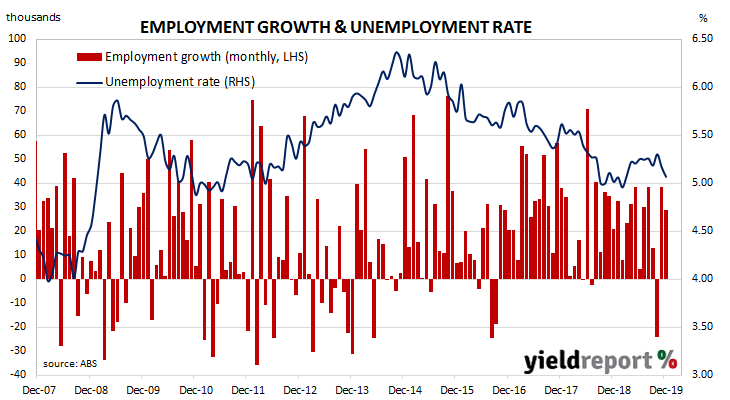Australia’s period of a falling unemployment rate may have come to an end but then again, it may be just another hiccup. After falling below 5% in late 2018, Australia’s jobless rate remained there through early 2019 until it moved higher in the June quarter. Recent leading indicators have been generally pointing towards further softness and the RBA is still generally expected to reduce its cash rate target one further time, something the central bank has traditionally done when it expects unemployment to rise.
The latest Labour force figures have now been released and they indicate the number of people employed in Australia increased by more than economists had expected. The report showed the total number of people employed in Australia increased by 28,900 in December while the unemployment rate improved from 5.2% to 5.1%.
ANZ senior economist Catherine Birch said, “The strength in employment over November/December and the associated decline in the unemployment rate…will reinforce the RBA’s view that the Australian economy appears to have reached a gentle turning point.” Market expectations prior to the report’s release were for 12,000 new positions to be created and for the unemployment rate to remain at 5.2%. Investors and traders reacted to the lower underemployment rate by sending yields higher at the short end while winding back expectations of rate cuts. By the end of the day, 90-day bank bills had jumped 5bps to 0.89% and the yield on 3-year ACGBs had gained 2bps to 0.72%. However, longer-term yields fell and 10-year and 20-year yields each finished 2bps lower at 1.11% and 1.52% respectively.
Market expectations prior to the report’s release were for 12,000 new positions to be created and for the unemployment rate to remain at 5.2%. Investors and traders reacted to the lower underemployment rate by sending yields higher at the short end while winding back expectations of rate cuts. By the end of the day, 90-day bank bills had jumped 5bps to 0.89% and the yield on 3-year ACGBs had gained 2bps to 0.72%. However, longer-term yields fell and 10-year and 20-year yields each finished 2bps lower at 1.11% and 1.52% respectively.

